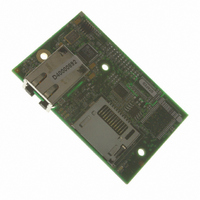20-101-1139 Rabbit Semiconductor, 20-101-1139 Datasheet - Page 22

20-101-1139
Manufacturer Part Number
20-101-1139
Description
RCM4310 RABBITCORE
Manufacturer
Rabbit Semiconductor
Datasheet
1.20-101-1139.pdf
(124 pages)
Specifications of 20-101-1139
Module/board Type
MPU Core Module
Product
Microcontroller Modules
Data Bus Width
8 bit
Core Processor
Rabbit 4000
Clock Speed
58.98 MHz
Interface Type
Ethernet
Flash
1 MByte
Timers
10 x 8 bit
Operating Supply Voltage
3.3 V
Board Size
72 mm x 47 mm x 21 mm
For Use With/related Products
RCM4310
Lead Free Status / RoHS Status
Lead free / RoHS Compliant
Other names
316-1142
Available stocks
Company
Part Number
Manufacturer
Quantity
Price
•
•
•
RabbitCore RCM4300 User’s Manual
SIMPLE3WIRE.C
communication. Lower case characters are sent on TxC, and are
received by RxD. The received characters are converted to upper case
and are sent out on TxD, are received on RxC, and are displayed in the
Dynamic C
To set up the Prototyping Board, you will need to tie TxD and RxC together on the
RS-232 header at J4, and you will also tie RxD and TxC together using the jumpers
supplied in the Development Kit as shown in the diagram.
SIMPLE5WIRE.C
with flow control on Serial Port C and data flow on Serial Port D.
To set up the Prototyping Board, you will need to tie TxD and RxD
together on the RS-232 header at J4, and you will also tie TxC and
RxC together using the jumpers supplied in the Development Kit as
shown in the diagram.
Once you have compiled and run this program, you can test flow con-
trol by disconnecting the TxC jumper from RxC while the program is running. Charac-
ters will no longer appear in the
connected back to RxC.
If you have two Prototyping Boards with modules, run this sample program on the
sending board, then disconnect the programming cable and reset the sending board so
that the module is operating in the Run mode. Connect TxC, TxD, and GND on the
sending board to RxC, RxD, and GND on the other board using jumper wires, then,
with the programming cable attached to the other module, run the sample program.
Once you have compiled and run this program, you can test flow control by disconnect-
ing TxC from RxC as before while the program is running. Since the J4 header locations
on the two Prototyping Boards are connected with wires, there are no slip-on jumpers at
J4 on either Prototyping Board.
SWITCHCHAR.C
ASCII string on Serial Ports C and D. It also displays the serial data received from both
ports in the
To set up the Prototyping Board, you will need to tie TxD and RxC
together on the RS-232 header at J4, and you will also tie RxD and
TxC together using the jumpers supplied in the Development Kit as
shown in the diagram.
Once you have compiled and run this program, press and release
switches S2 and S3 on the Prototyping Board. The data sent between the serial ports
will be displayed in the
STDIO
STDIO
—This program demonstrates transmitting and then receiving an
—This program demonstrates basic RS-232 serial
—This program demonstrates 5-wire RS-232 serial communication
window.
window.
STDIO
window.
STDIO
window, and will display again once TxC is
22


















